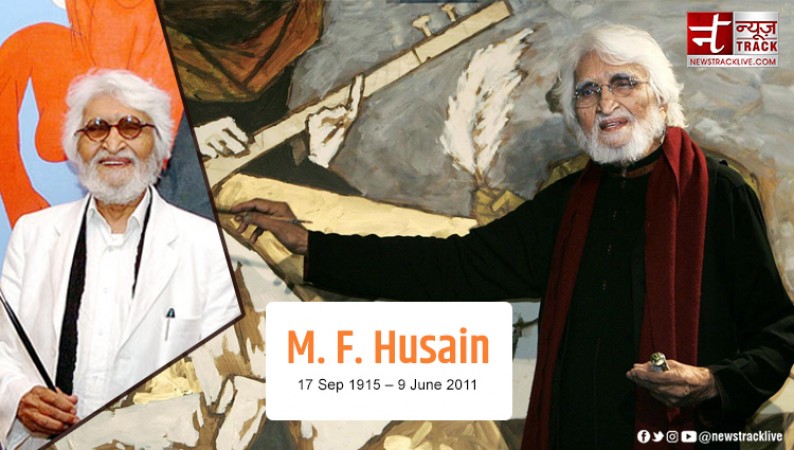
On September 17th, art enthusiasts and admirers around the world commemorate the birthday of the legendary Indian artist, M. F. Husain. Born Maqbool Fida Husain in Pandharpur, Maharashtra, on this day in 1915, he left an indelible mark on the world of art and culture. As we remember the man often referred to as the Picasso of India, let us delve into his remarkable life, prolific career, and enduring legacy.
Early Life and Artistic Beginnings
Husain's journey into the world of art was nothing short of extraordinary. His early life was marked by a deep passion for creativity and an innate talent for painting. His initial education in a Madrasa laid the foundation for his future artistic pursuits. However, it was during his time in Baroda that he discovered his love for calligraphy and began honing his skills in this intricate art form.
The young Husain was deeply influenced by the works of French painter Brancusi, particularly two captivating portraits of Maharaja Yashwantrao Holkar and his wife. These paintings left an indelible impression on him and fueled his aspiration to create art that would transcend boundaries.
Even at the tender age of 15, Husain embarked on his artistic journey by painting cinema posters in the bustling city of Mumbai. To make ends meet, he also lent his creative talents to a toy company, where he designed and crafted toys. His relentless pursuit of his artistic passions led him to Gujarat, where he would often travel to paint landscapes, embracing the diversity of India's cultural and geographical tapestry.
Pioneering the Progressive Art Movement
M. F. Husain's influence on Indian art can hardly be overstated. In 1947, he achieved recognition and acclaim by winning a prestigious prize at the annual Bombay Art Society exhibition. This pivotal moment in his career marked the beginning of a trajectory that would redefine the Indian art landscape.
The same year, he received an invitation from Francis Newton Souza to join the Progressive Artists' Group, a collective of visionary artists who sought to break away from the constraints of traditional art styles that had dominated the pre-Independence era. This group, consisting of luminaries like Husain, Syed Haider Raza, Krishna Hawlaji Ara, Hari Amba Das Gade, and S. Bakre, aimed to infuse new energy and purpose into Indian art.
Husain's distinctive style, marked by bold colors and powerful symbolism, soon became a hallmark of this progressive movement. His works embodied the essence of a rapidly changing India, caught between tradition and modernity. His canvases came alive with vibrant depictions of Indian mythology, folklore, and the daily lives of its people.
A Global Artistic Journey
Husain's artistic prowess knew no bounds, and his works transcended geographical boundaries. In 1952, he held his first solo art exhibition in Zürich, Switzerland, taking his unique vision to international audiences. This was just the beginning of his global artistic journey.
The United States welcomed Husain's art with open arms when his work was exhibited at India House in New York City in 1964. His distinctive style and subject matter resonated with audiences far beyond the Indian subcontinent.
One of the most notable milestones in Husain's international career was his special invitation, alongside the legendary Pablo Picasso, to the São Paulo Biennial in Brazil in 1971. This event showcased the global recognition and respect that he had garnered as an artist of unparalleled talent and vision.
Husain's creative genius extended beyond the canvas. In 1967, he received the National Film Award for Best Experimental Film for "Through the Eyes of a Painter," a documentary that offered a glimpse into his artistic process and vision. His foray into cinema continued with the 2004 film "Meenaxi: A Tale of Three Cities," a collaboration with his artist son, Owais Husain, which was screened at the prestigious Cannes Film Festival.
Political Engagement and Legacy
While M. F. Husain is primarily celebrated as an artist, his engagement with politics added yet another facet to his multifaceted persona. From May 12, 1986, to May 11, 1992, he served as a member of the upper house of India's parliament, an unusual role for a figure of his artistic stature. This period allowed him to influence policy and engage with the broader social and political issues of the day.
Husain's life and career continue to inspire artists, scholars, and art enthusiasts worldwide. His biography, written by Akhilesh and aptly titled "Maqbool," stands as a testament to his enduring influence. Published by Rajkamal Prakashan in New Delhi, this book delves into the intricate details of his life, providing a comprehensive look at the man behind the art.
As we celebrate the birthday of M. F. Husain, we are reminded of his profound impact on the world of art, his tireless pursuit of creativity, and his ability to transcend boundaries through his work. His legacy serves as an inspiration to future generations, urging them to explore the boundless possibilities of artistic expression and to embrace the rich tapestry of culture and heritage that defines India.
In his honor, art galleries, museums, and institutions around the world continue to showcase his masterpieces, ensuring that his art remains a source of inspiration and contemplation for generations to come. M. F. Husain's legacy endures, reminding us that art has the power to transcend time and place, touching the soul and sparking the imagination of all who encounter it.